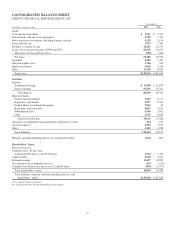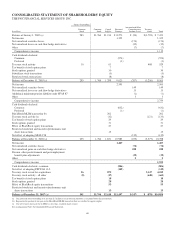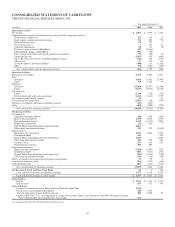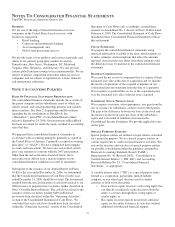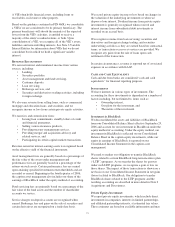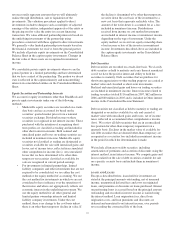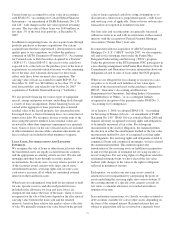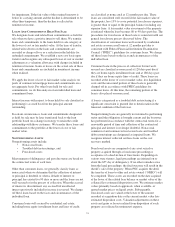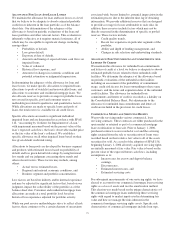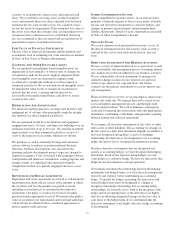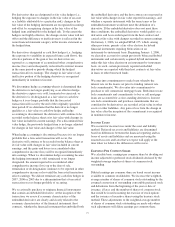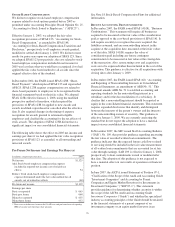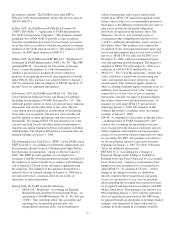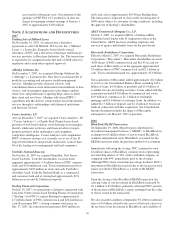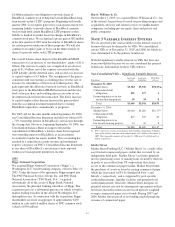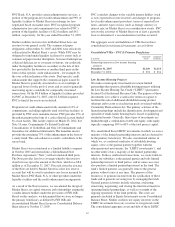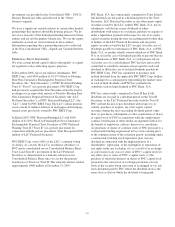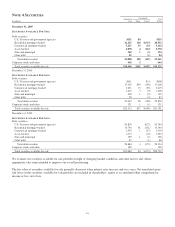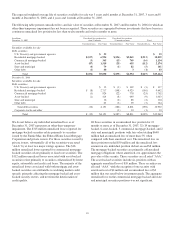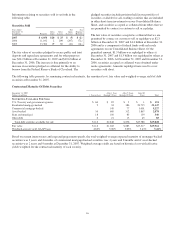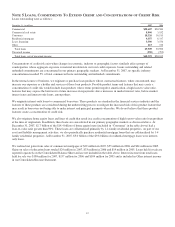PNC Bank 2007 Annual Report Download - page 82
Download and view the complete annual report
Please find page 82 of the 2007 PNC Bank annual report below. You can navigate through the pages in the report by either clicking on the pages listed below, or by using the keyword search tool below to find specific information within the annual report.For derivatives that are designated as fair value hedges (i.e.,
hedging the exposure to changes in the fair value of an asset
or a liability attributable to a particular risk), changes in the
fair value of the hedging instrument are recognized in earnings
and offset by recognizing changes in the fair value of the
hedged item attributable to the hedged risk. To the extent the
hedge is not highly effective, the changes in fair value will not
offset and the difference or ineffectiveness is reflected in the
same financial statement category in the income statement as
the hedged item.
For derivatives designated as cash flow hedges (i.e., hedging
the exposure to variability in expected future cash flows), the
effective portions of the gain or loss on derivatives are
reported as a component of accumulated other comprehensive
income (loss) and subsequently reclassified to interest income
in the same period or periods during which the hedged
transaction affects earnings. The change in fair value of any
ineffective portion of the hedging derivative is recognized
immediately in noninterest income.
We discontinue hedge accounting when it is determined that
the derivative is no longer qualifying as an effective hedge;
the derivative expires or is sold, terminated or exercised; or
the derivative is de-designated as a fair value or cash flow
hedge or it is no longer probable that the forecasted
transaction will occur by the end of the originally specified
time period. If we determine that the derivative no longer
qualifies as a fair value or cash flow hedge and hedge
accounting is discontinued, the derivative will continue to be
recorded on the balance sheet at its fair value with changes in
fair value included in current earnings. For a discontinued fair
value hedge, the previously hedged item is no longer adjusted
for changes in fair value and changes of the fair value.
When hedge accounting is discontinued because it is no longer
probable that a forecasted transaction will occur, the
derivative will continue to be recorded on the balance sheet at
its fair value with changes in fair value included in current
earnings, and the gains and losses in accumulated other
comprehensive income (loss) will be recognized immediately
into earnings. When we discontinue hedge accounting because
the hedging instrument is sold, terminated or no longer
designated, the amount reported in accumulated other
comprehensive income (loss) up to the date of sale,
termination or de-designation continues to be reported in other
comprehensive income or loss until the forecasted transaction
affects earnings. We did not terminate any cash flow hedges in
2007, 2006 or 2005 due to a determination that a forecasted
transaction was no longer probable of occurring.
We occasionally purchase or originate financial instruments
that contain an embedded derivative. At the inception of the
transaction, we assess if economic characteristics of the
embedded derivative are clearly and closely related to the
economic characteristics of the financial instrument (host
contract), whether the financial instrument that embodied both
the embedded derivative and the host contract are measured at
fair value with changes in fair value reported in earnings, and
whether a separate instrument with the same terms as the
embedded instrument would not meet the definition of a
derivative. If the embedded derivative does not meet these
three conditions, the embedded derivative would qualify as a
derivative and be recorded apart from the host contract and
carried at fair value with changes recorded in current earnings.
On January 1, 2006, we adopted SFAS 155, which, among
other provisions, permits a fair value election for hybrid
financial instruments requiring bifurcation on an
instrument-by-instrument basis. Beginning January 1, 2006,
we elected to account for certain previously bifurcated hybrid
instruments and certain newly acquired hybrid instruments
under this fair value election on an instrument-by-instrument
basis. As such, certain previously reported embedded
derivatives are reported with their host contracts at fair value
in loans or other borrowed funds.
We enter into commitments to make loans whereby the
interest rate on the loan is set prior to funding (interest rate
lock commitments). We also enter into commitments to
purchase or sell commercial mortgage loans. Both interest rate
lock commitments and commitments to buy or sell mortgage
loans are accounted for as free-standing derivatives. Interest
rate lock commitments and purchase commitments that are
considered to be derivatives are recorded at fair value in other
assets or other liabilities. Any gain or loss from the change in
fair value after the inception of the commitment is recognized
in noninterest income.
I
NCOME
T
AXES
We account for income taxes under the asset and liability
method. Deferred tax assets and liabilities are determined
based on differences between the financial reporting and tax
bases of assets and liabilities and are measured using the
enacted tax rates and laws that we expect will apply at the
time when we believe the differences will reverse.
E
ARNINGS
P
ER
C
OMMON
S
HARE
We calculate basic earnings per common share by dividing net
income adjusted for preferred stock dividends declared by the
weighted-average number of shares of common stock
outstanding.
Diluted earnings per common share are based on net income
available to common stockholders. We increase the weighted-
average number of shares of common stock outstanding by the
assumed conversion of outstanding convertible preferred stock
and debentures from the beginning of the year or date of
issuance, if later, and the number of shares of common stock
that would be issued assuming the exercise of stock options
and the issuance of incentive shares using the treasury stock
method. These adjustments to the weighted-average number
of shares of common stock outstanding are made only when
such adjustments will dilute earnings per common share.
77


